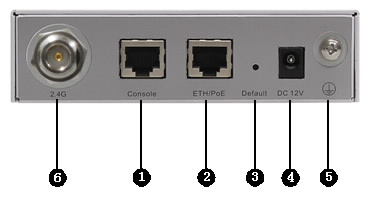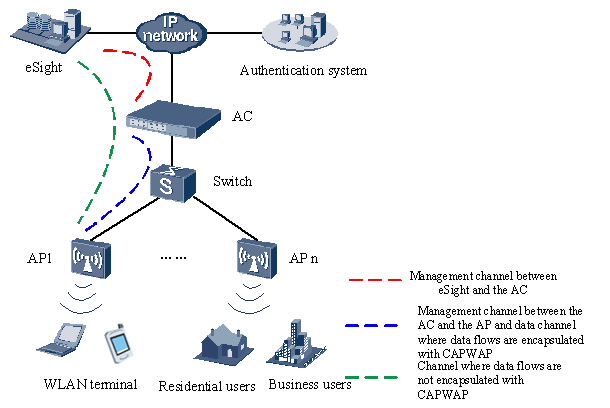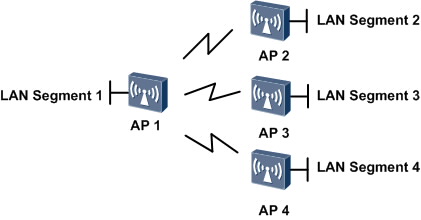AP6310SN Indoor distributed Single-band AP
The AP6310SN is a cost-efficient single-band AP that supports the 2.4 GHz frequency band and provides full power. It complies with IEEE 802.11a/b/g/n, and works as a Fit AP.

Highly reliable wireless access
- Complies with IEEE 802.11 b/g/n
- Provides a maximum rate of 150 Mbit/s for each radio
- Uses Wi-Fi Multimedia (WMM) to implement priority scheduling based on the service type (voice, video, or data), and implements end-to-end QoS through priority mapping on wireless and wired interfaces
- Supports wired link integrity check
- Supports load balancing
- Supports roaming without service interruptions
- Supports AC hot standby
- Uses the latest 802.11n chip to increase the performance by 20%
- Has a strong coverage capability
- Uses a metal shell and a design that dissipates heat for high reliability.
Comprehensive user access control capability
- Supports access control lists (ACLs) and user access controls based on user group policies
- Provides per-user bandwidth management
- Supports user isolation policies
High security
- Wired Equivalent Privacy (WEP)
- Wi-Fi Protected Access (WPA)/WPA2
- WLAN Authentication and Privacy Infrastructure (WAPI)
- 802.1x
- Detection of unauthorized APs
Flexible networking and environment adaptability
- For use in Fit AP and WDS networking scenarios
- Automatically selects the transmission rate, channel, and transmit power to adapt to multiple radio environments and limit interference in real time
- Adjusts bandwidth allocation based on the number of users and radio environment.
Simple device management and maintenance
- Automatically discovers ACs and loads the AC (plug-and-play) configuration.
- Supports batch upgrade
- Monitored by the NMS in real time. You can remotely configure APs and locate faults on APs using the NMS
- Supports the Link Layer Discovery Protocol (LLDP) to implement automatic link discovery and obtain the network topology
WLAN features
- Compliance with IEEE 802.11b/g/n, providing a maximum rate of 150 Mbit/s for each radio
- Priority mapping and packet scheduling based on a Wi-Fi Multimedia (WMM) profile to implement priority-based data processing and forwarding
- Automatic and manual rate adjustment (the rate is adjusted automatically by default)
- WLAN channel management and channel rate adjustment
- Automatic channel scanning (the AP6310SN scans channels used by other APs, measures their interference, and reports the scanning result to the AC to trigger channel adjustment)
- Service set identifier (SSID) hiding
- Signal sustain technology (SST)
- STA power-saving mode
- Control and Provisioning of Wireless Access Points (CAPWAP)
- Automatic AC discovery
Network features
- Compliance with IEEE 802.3u
- Ports: Auto-negotiation of the rate and duplex mode and automatic switching between the Media Dependant Interface (MDI) and Media Dependant Interface Crossover (MDI-X) mode
- 1024 unicast MAC addresses
- VLAN assignment based on SSIDs
- VLAN aggregation on uplink Ethernet ports
- 4093 VLAN IDs (1-4093) and 16 virtual APs (VAPs)
- Uplink ports in tagged and untagged mode
- DHCP client
- PPPoE dialup
- Centralized data forwarding and local data forwarding
- STA isolation in the same VLAN
- ACL
- LLDP
QoS features
- Priority mapping and packet scheduling based on WMM profiles to implement priority-based data processing and forwarding
- WMM parameter management for each radio frequency
- WMM power saving
- Priority mapping for upstream packets and flow-based mapping for downstream packets
- Queue mapping and scheduling
- User-based bandwidth limiting
- Adaptive bandwidth allocation (the system dynamically adjusts bandwidth based on the number of users and radio environment)
Security features
- Open system authentication
- WEP authentication/encryption
- WPA/WPA2 authentication and encryption
- 802.1x authentication and encryption
- WAPI authentication and encryption
- SMS4 decryption for data packets
- Wired link integrity check (the AP stops sending radio signals if the tunnel between the AP and AC is terminated)
Maintenance features
- AP management and maintenance by the AC
- Plug-and-play: automatic AC discovery and automatic configuration loading
- Batch upgrade
- Debugging using Telnet and the serial interface
- Real-time configuration monitoring and fast fault location by using the NMS
- System status alarm
Specifications
Antenna Parameters
Appearance
Ports

1.Console port.
2. ETH/PoE: 10/100/1000M port, which connects to the Ethernet. The port can connect to a PoE switch or a PoE power source to provide power for APs.
3.Default: restores factory settings.
4. Power input port: 12 V DC.
5. Ground point: connects to a ground cable.
6. N-type radio connector port.
LED Indicators
| Information Type | SYS | Link | Wireless | Description |
|---|---|---|---|---|
| Startup status | Steady green | Off | Off | The device is being started. |
| Blinking green | Off | Off | The system is working properly. | |
| Steady red | Off | Off | The system fails to load the DRAM or system software. | |
| Service status indicator | Blinking (0.5Hz) | Off | Off | The system is working properly, but the Ethernet is not connected and radios or all VAPs are disabled. |
| Blinking (0.5Hz) | Off | The wireless indicator blinks green more quickly as more packets are received on the air port. | The system is working properly, but the Ethernet is not connected. STAs are connected . | |
| Blinking (0.5Hz) | The indicator is steady green if no data is transmitted. The indicator blinks green more quickly when more packets are transmitted. | Off | The system is working properly and the Ethernet is connected, but radios or all VAPs are disabled. | |
| Blinking (0.5Hz) | The indicator is steady green if no data is transmitted. The indicator blinks green more quickly when more packets are transmitted. | The wireless indicator blinks green more quickly as more packets are received on the air port. | The system is working properly, the Ethernet is connected, and STAs are connected. |
The AP6310SN is recommended on large-scale networks where users are distributed in a large area and an indoor distribution system is used, for example, office buildings, business buildings, hotels, airports, and bus stations. The AP6310SN APs provide indoor wireless signal coverage in these scenarios.
Fit AP networking:

In this networking, the AP6310SN functions as a Fit AP that provides only data forwarding functions. The AC is responsible for user access, authentication, AP management, and configurations of security protocols, routing, and QoS.
WDS networking (point-to-point):

WDS networking (point-to-multipoint):
In this networking, the AP6310SN connects two or more independent wired or wireless LANs through wireless links. In a Wireless Distribution System (WDS), the AP6310SN supports point-to-point, point-to-multipoint, and multipoint-to-multipoint networking modes.
Utiles Produits
- AP7130DN-AC Indoor Dual-band AP
- AP7030DN-AC Indoor Dual-band AP
- AP5010DN-AGN Indoor Dual-band AP
- AP5010SN-GN Indoor Single-band AP
- AP7110DN-AGN Indoor Dual-band AP
- AP7110SN-GN Indoor Single-band AP
- AP6610DN Outdoor Dual-band AP
- AP6010SN Indoor Single-band AP
- AP6010DN Indoor Dual-band AP
- AP6510DN Outdoor Dual-band AP




















